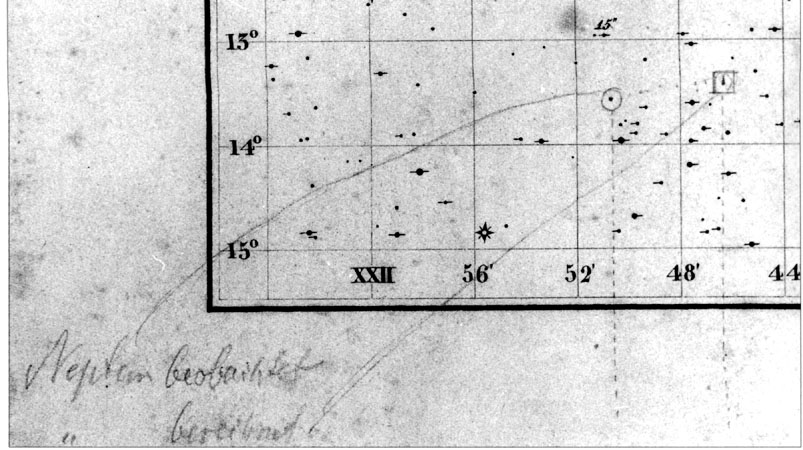
Chart of Neptune's discovery courtesy of L'HISTOIRE DU CONCEPT DE GRAVITATION
 Copyright © Michael Richmond.
This work is licensed under a Creative Commons License.
Copyright © Michael Richmond.
This work is licensed under a Creative Commons License.
|
Some administration to start:
Please fill out an on-line evaluation form right now. |
Astronomers were well aware of the possibility that an otherwise invisible object might be detected by its gravitational influence on somethat that we could see. For example, this planet in our own solar system:

Chart of Neptune's discovery courtesy of
L'HISTOIRE DU CONCEPT DE GRAVITATION
Or the curious motions of Sirius as it moves through the sky:
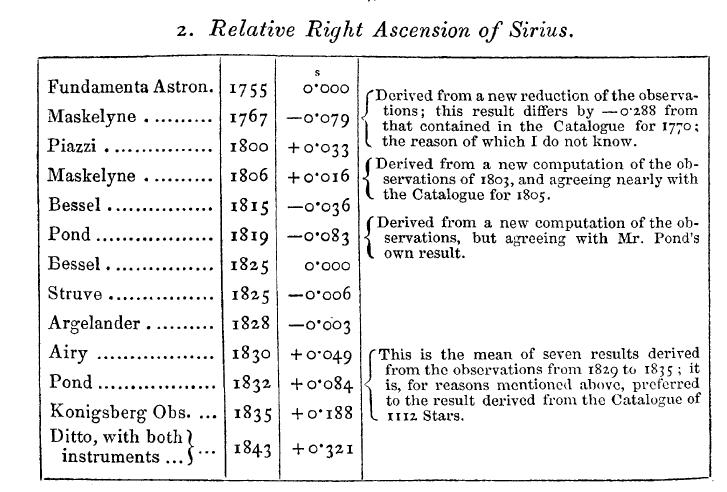
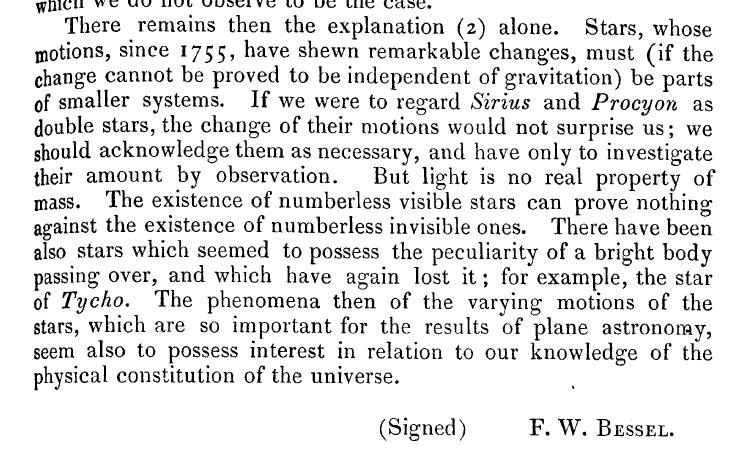
Excerpts from
Bessel, MNRAS 6, 136 (1844)
Peter van de Kamp measured the position of Barnard's Star for many years, using the 61-cm Sproul refracting telescope at Swarthmore College.
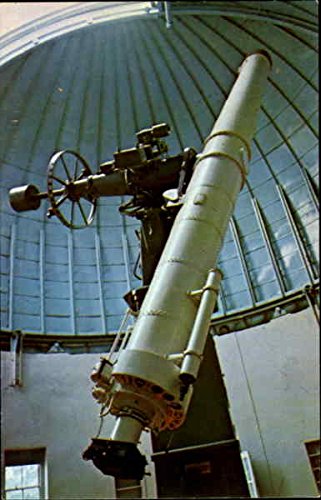
Image courtesy of
amazon.com
He exposed photographic plates which showed Barnard's Star and a small number of nearby reference stars, then measured those plates with a mechanical engine. Over the period 1938 to 1968, he found small variations in the position of Barnard's Star relative to those references. It wasn't moving in a straight line through the sky, but in a wiggling path:
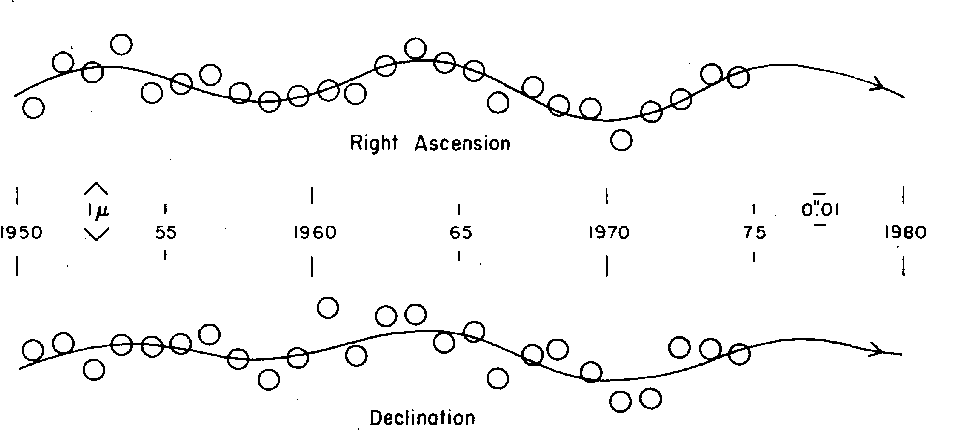
Figure taken from
van de Kamp, AJ 80, 658 (1975)
Van de Kamp attributed these wiggles to the gravitational influence of two planets with pretty long orbital periods:
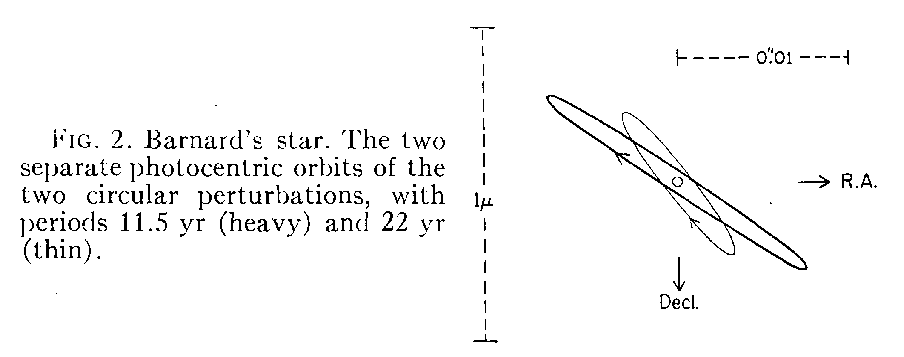
Figure taken from
van de Kamp, AJ 80, 658 (1975)
One of the planets has a period of 11.5 years, an orbit with a semi-major
axis of 2.71 AU, and a mass of 0.0063 of its host star.
Q: Barnard's Star must move around its center of mass
with this planet. How many AU would the radius
of this motion be?
Q: Barnard's Star is only 1.82 pc from the Sun -- it is
the second-closest star.
How many arcseconds would Barnard's Star move
around this center-of-mass?
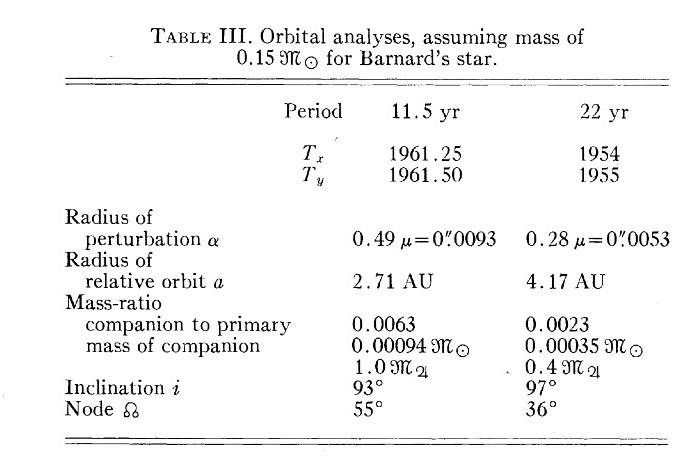
Figure taken from
van de Kamp, AJ 80, 658 (1975)
Needless to say, measuring such small changes in the position of a star is hard. Really hard.
Other astronomers raised some concerns about the measurements of these plates from the Sproul refractor. In the graph below, the vertical tickmarks are roughly TWICE the size of the claimed reflex motions of Barnard's Star.
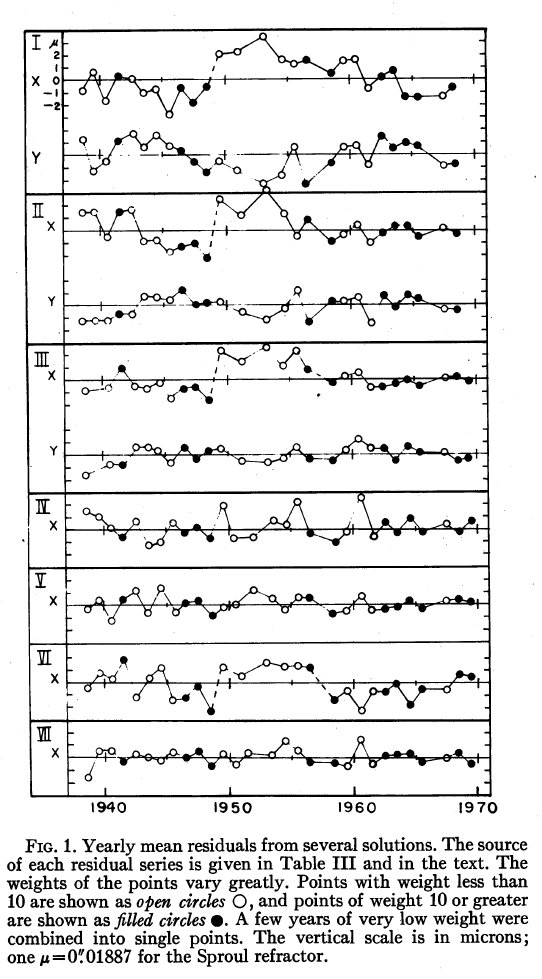
Figure taken from
Hershey, AJ 78, 421 (1973)
In the late 1990s, astronomers used the Fine Guidance Sensors on HST to measure the position of Barnard's Star over a five-year period.
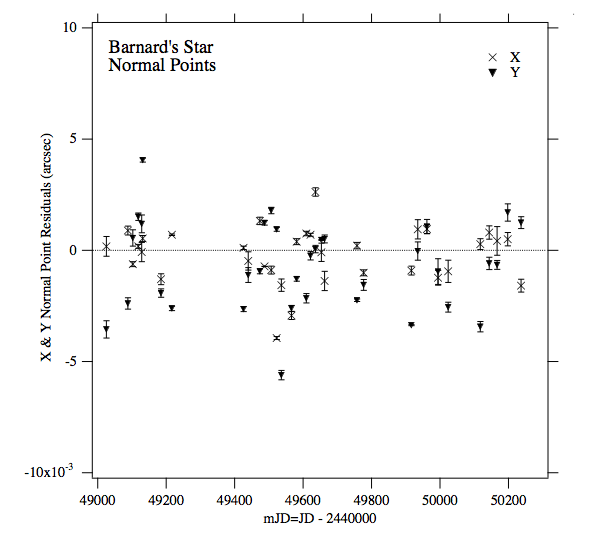
Figure taken from
Benedict et al., AJ 118, 1086 (1999)
Q: How large should the claimed motion of Barnard's Star
appear on this graph?
Astronomers have also looked for the radial velocity variations in Barnard's Star due to the putative planets -- though over a short 2.5-year period.
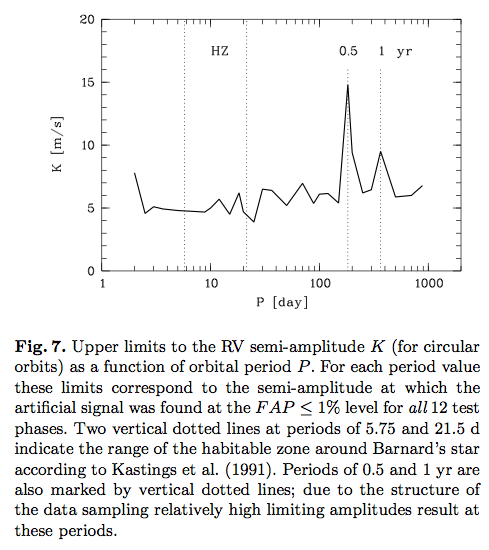
Figure 7 from
Kurster et al., A&A 403, 1077 (2003)
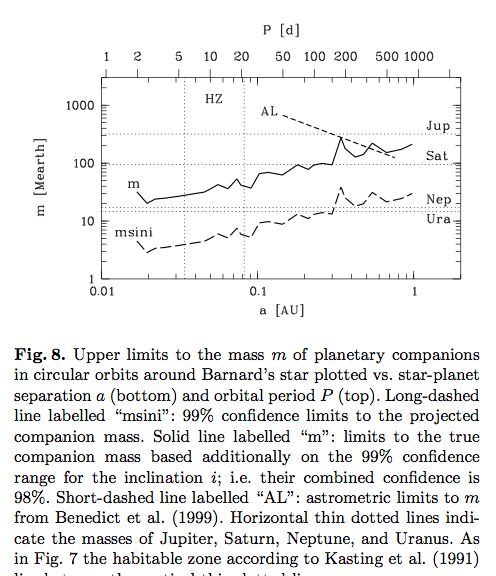
Figure 8 from
Kurster et al., A&A 403, 1077 (2003)
Alas, in this particular case, it appears that the search did not yield a planet.
The FIRST detection of planets around a star other than our Sun involved objects circling a neutron star, announced by Wolszczan and Frail, Nature 355, 145 (1992). But most people ignore this.
The NEXT detection of planets around a star -- this time an ordinary, main-sequence star -- was announced by Mayor and Queloz, Nature 378, 355 (1995). Was this a stroke of luck?
No, it was part of a plan. Mayor and his colleagues had been interested in using radial velocity measurements to search for stellar companions for many years.
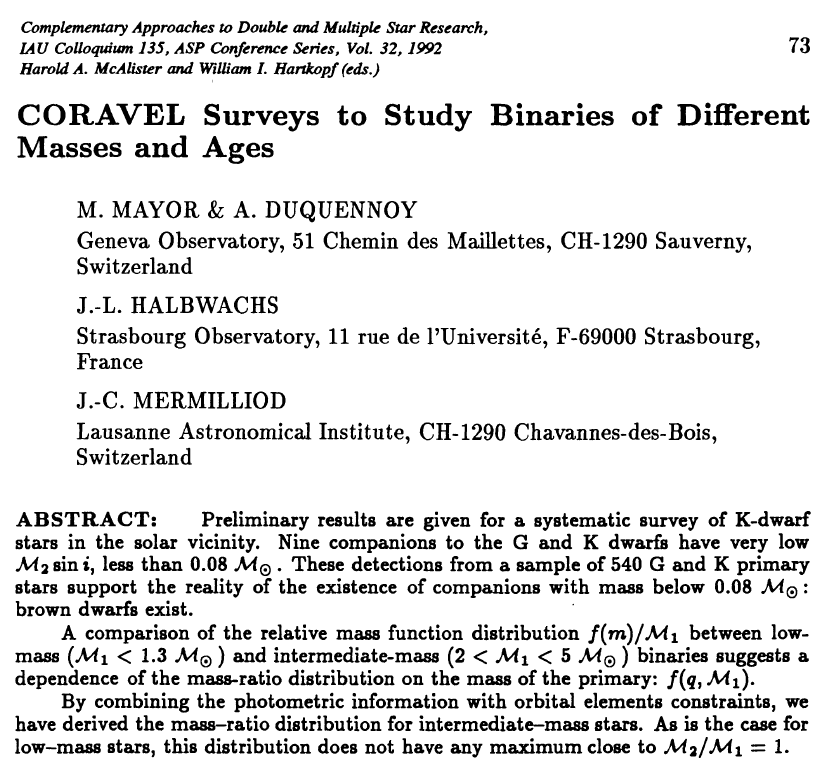
Abstract of
Mayor et al., ASPC 32, 73 (1992)
The group first used the CORAVEL spectrometer, which was put into service in 1977. Its properties are summarized in an article on its twin, installed in the southern hemisphere.
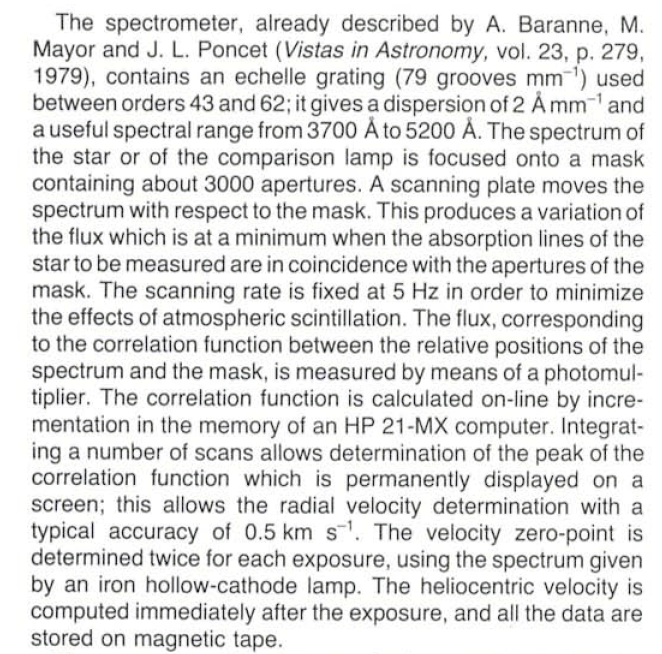
Q: What is the precision of measurements made with CORAVEL?
Q: What is the amplitude of radial velocity variations
induced in the Sun by Jupiter?
Based on the success of CORAVEL, a new spectrograph was installed at the Observatoire de Haute-Provence (OHP) in 1993: ELODIE. Some of its features:
The cross-dispersed design allowed ELODIE to collect a huge amount of information from a star in a single exposure.
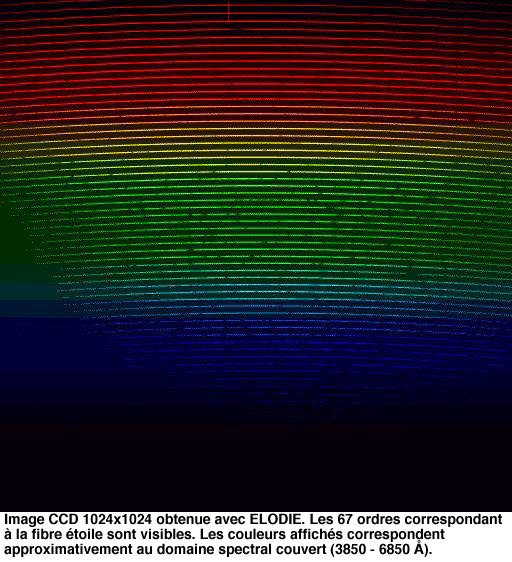
Image courtesy of
http://www.obs-hp.fr/nouvelles/elodie.html
The instrument was also efficient, as Baranne et al. (1994) state:
The efficiency and accuracy of the instrument and its long term instrumental stability allow us to measure radial velocities with an accuracy better than 15 m s-1 for stars up to 9th magnitude in less than 30 minutes exposure time.
Mayor and his team requested time on ELODIE starting 1993 to peform a survey of 142 stars known to be single and constant in luminosity. Their goal: look for companions with small mass -- other stars, brown dwarfs, maybe even planets.
They started their survey in April 1994. By the fall of 1994, they noticed some variability in one particular star, 51 Peg. After several additional months of observation, they were able to compute a decent ephemeris for the variations ... but, just as they were nailing down the parameters of their fit, something happened:
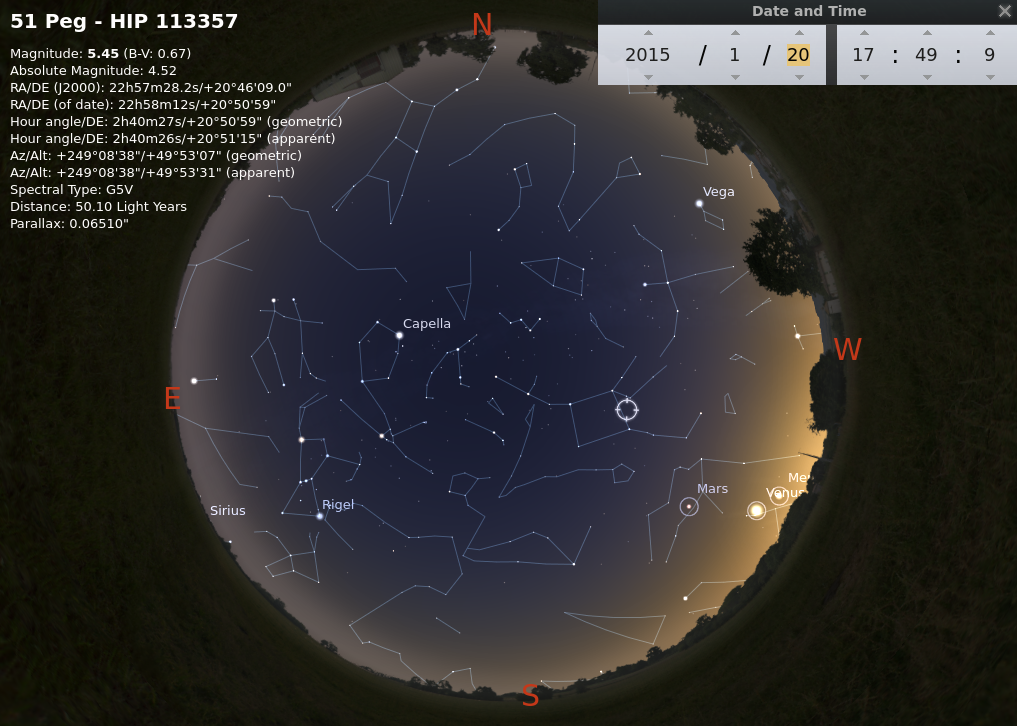
Yes, the stupid Sun got in the way.
It wasn't until July, 1995, that the team was able to observe 51 Peg again. They confirmed that the variations were still present, and had the same properties measured the previous year.
On October 6, 1995, the team announced their discovery at a meeting in Florence, Italy. Their paper was published in Nature on Nov 23, 1995.

Abstract from
Mayor and Queloz, Nature 378, 355 (1995)
Over the next ten years, this group expanded their survey to use the CORALIE spectrograph, a southern-hemisphere twin to ELODIE, mounted on the 1.2-m Leonard Euler Telescope at ESO's La Silla location in Chile. Their effort was known as the Southern Sky extrasolar Planet search Programme. It found (at least) 34 planets up to 2004.
This group also participated in the design of the next generation of high-precision spectrographs, High Accuracy Radial velocity Planet Searcher (HARPS). Mounted on the 3.6-m telescope at La Silla, this instrument can find planets around fainter stars than the earlier models, and can achieve higher precision as well. HARPS has found over 140 exoplanets, according to its Wikipedia entry.
In 2003, a group of astronomers with ties to eastern Europe decided that even small telescopes could get into the planet-hunting business. After all, the first detection of an extrasolar planetary transit had been made with a 4-inch telescope back in 1999. The result was the Hungarian-made Automated Telescope (HAT) system, which soon grew into a group of telescopes: HATNet.
The devices are small and automated, designed to operate with no human present. The first telescope was based on a Nikon telephoto camera lens, but later versions employ a Canon 200mm f/1.8 lens ...
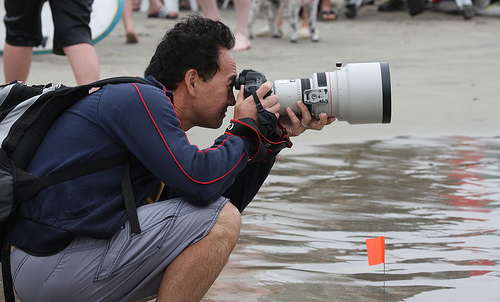
Image courtesy of
Nathan Rupert
... or a small Takahashi 180mm f/2.8 refracting telescope:
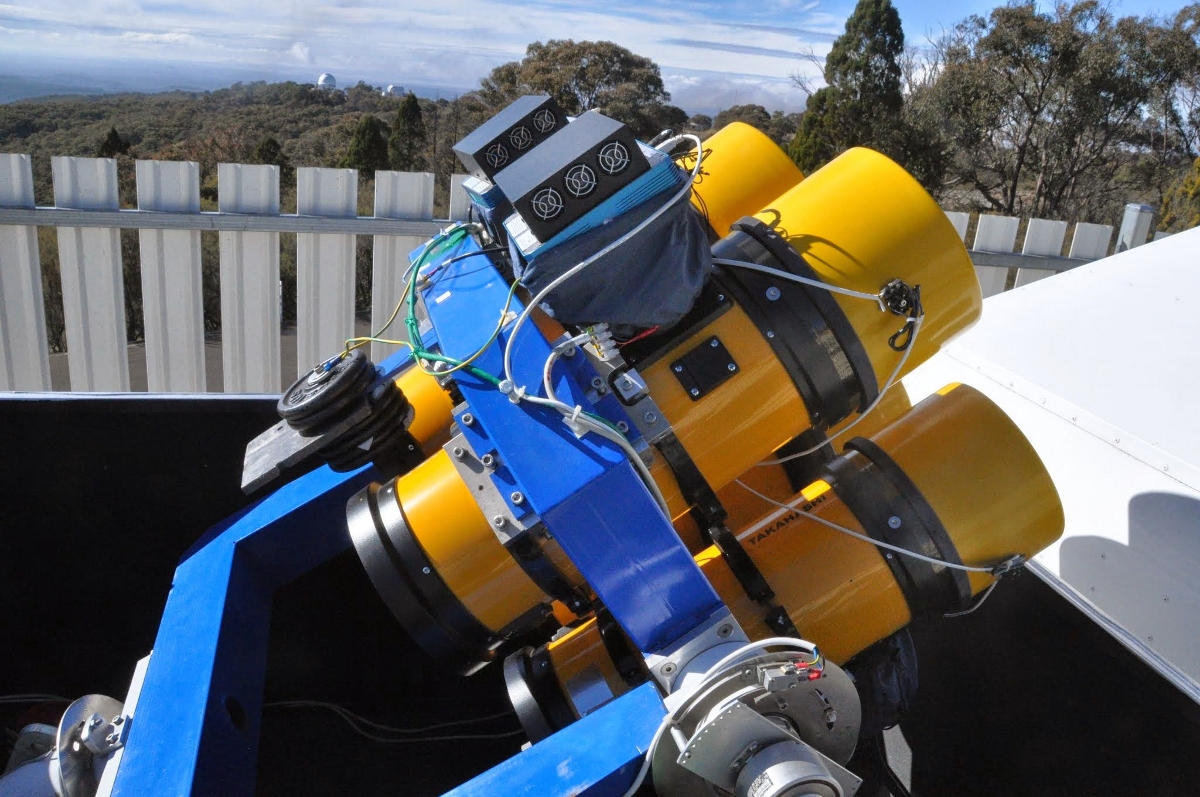
Image courtesy of
HAT-South and Gaspar Bakos
Each camera focuses light onto a CCD, providing images over a wide field. The Canon lenses yield a field of view of about 10.5-by-10.5 degrees, with big pixels: about 9 arcseconds on a side.
The Good News is
The Bad News is
It may help to compare an actual HAT image against a "typical" image; the example below is the open cluster M34. The field of view is about 25-by-25 arcminutes in both cases (just a bit smaller than the full moon).
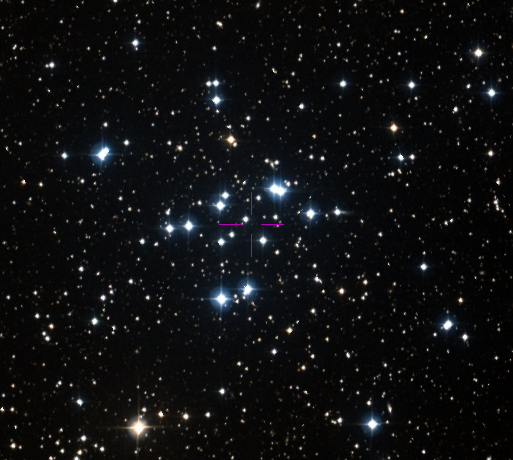
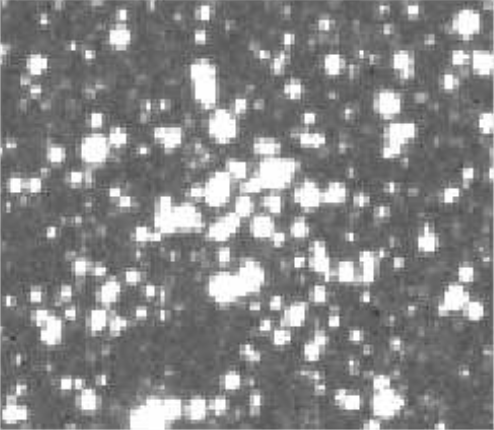
(right panel) Part of figure 3 taken from
Bakos et al., PASP 116, 266 (2004)
One of the ingenious methods employed by the HAT group to improve the precision of their photometric measurements was to make the PSF broader and more uniform by jittering the telescope during exposures.
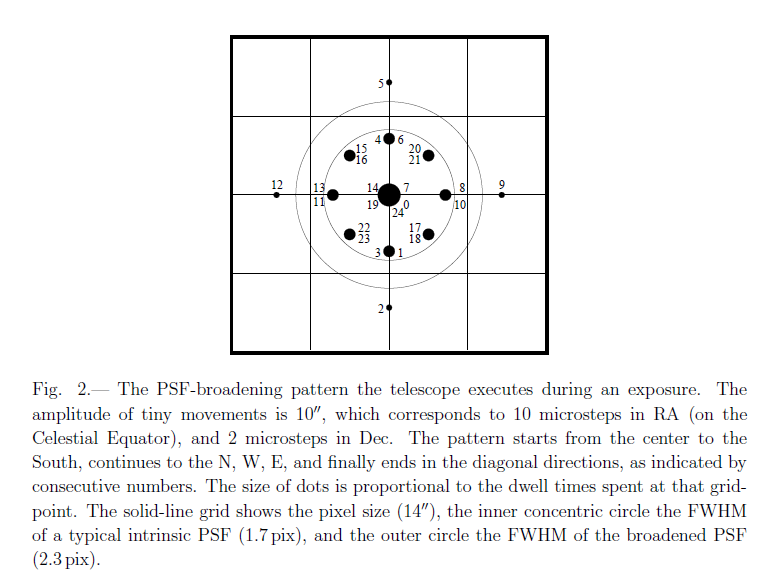
Figure 2 from
Bakos et al., PASP 116, 266 (2004)
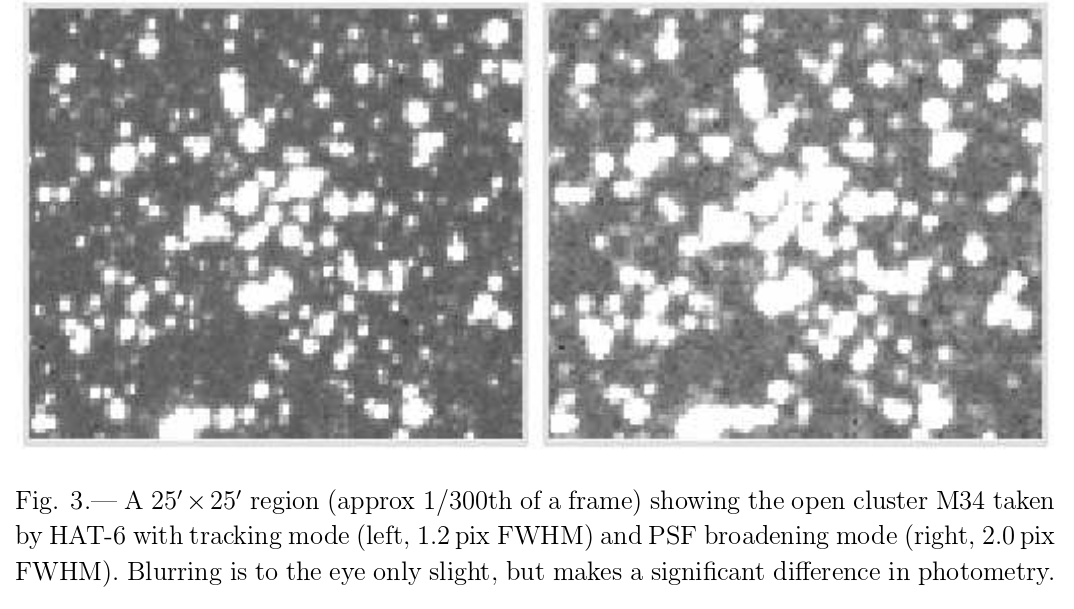
Figure 3 taken from
Bakos et al., PASP 116, 266 (2004)
It sounds crazy to BROADEN the PSF, but it does end up improving the precision of the photometry of bright stars.
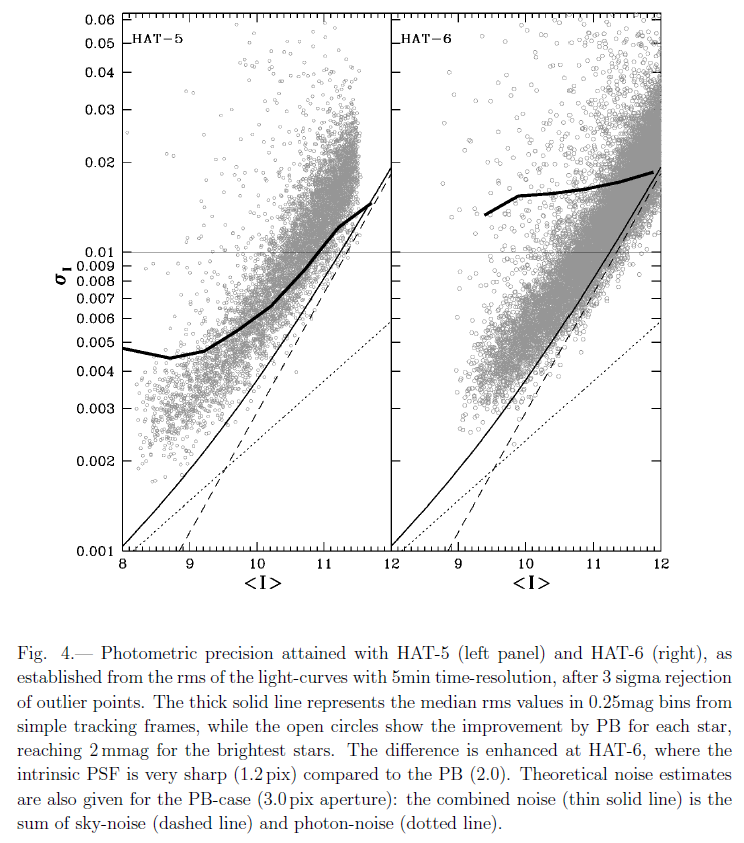
Figure 4 from
Bakos et al., PASP 116, 266 (2004)
Q: What is the smallest variation in a star's light
that these telescopes could detect?
Q: Do any planets in our solar system create
transits which these telescopes could detect?
Let's look at one example of a planet discovered by the HAT team: HD 147506b.
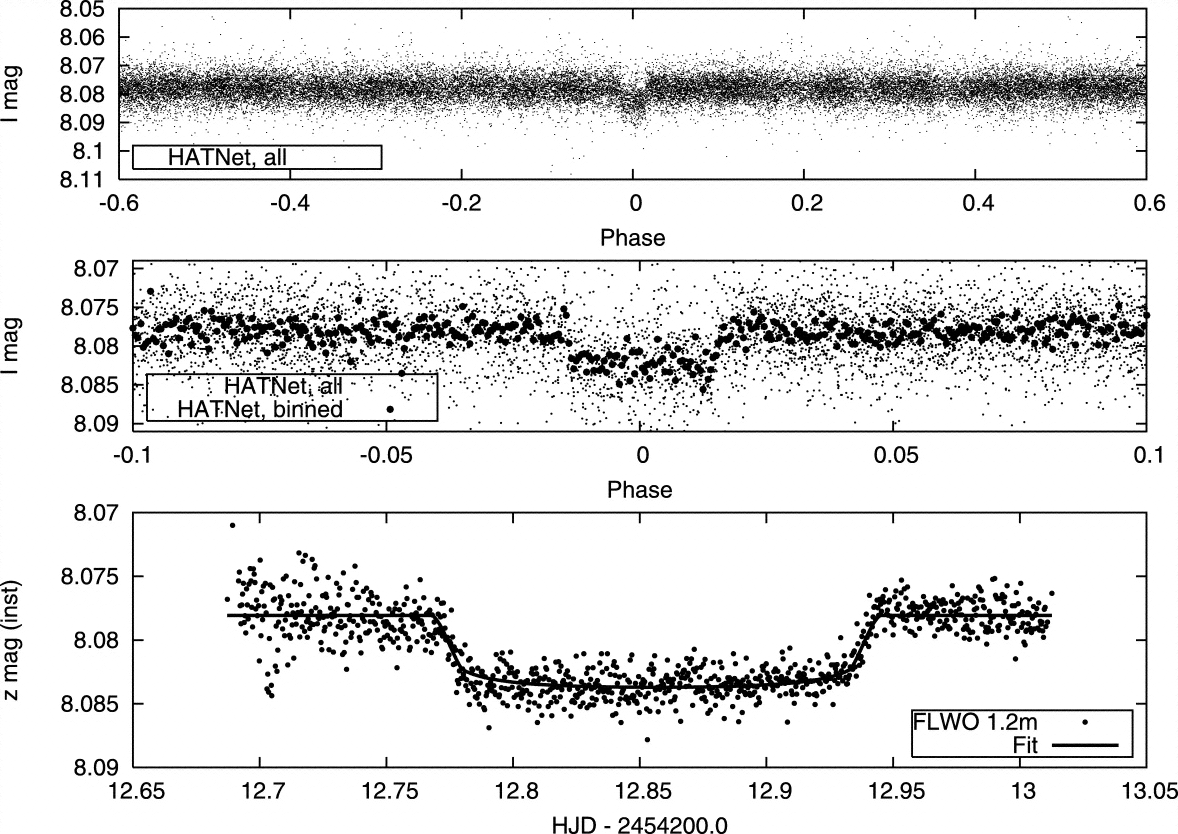
Figure 1 from
Bakos et al., ApJ 670, 826 (2007)
A good reference for the steps the team must take as they sift through the millions of measurements to find bona fide planets can be found in
These steps include
By the end of the process, an original set of over one thousand candidates may have shrunk to a few real planets.
The HAT team has discovered at least 60 planets over the period 2006 - 2015. Recall that they began their survey in 2003, so there was a period of several years at the start when they were still figuring out the properties of their instruments and data reduction.
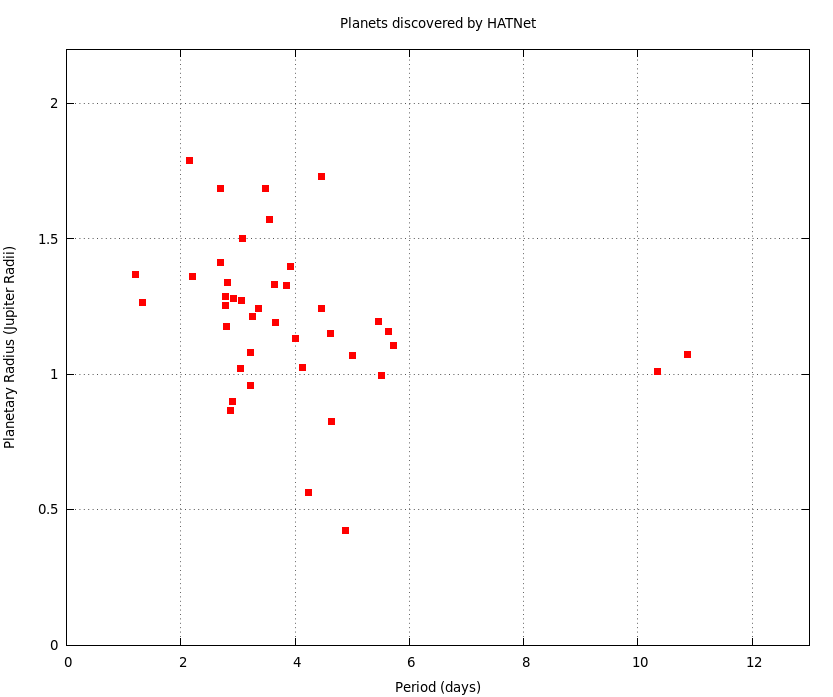
Of course, the HAT team has acquired a boatload of data on stars -- ordinary stars, eclipsing stars, flaring stars, pulsing stars -- in the course of their search for planets. They have published a few results using that data ...
 Copyright © Michael Richmond.
This work is licensed under a Creative Commons License.
Copyright © Michael Richmond.
This work is licensed under a Creative Commons License.